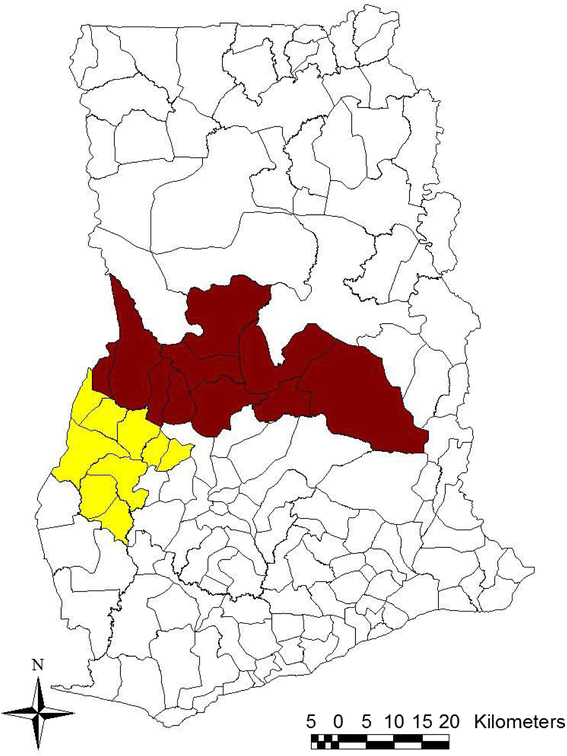Factors associated with syphilis screening uptake among pregnant women in health facilities in Brong Ahafo Region of Ghana
- PMID: 27057324
- PMCID: PMC4823680
- DOI: 10.1186/s40748-015-0009-2
Factors associated with syphilis screening uptake among pregnant women in health facilities in Brong Ahafo Region of Ghana
Abstract
Background: Congenital syphilis is a consequence of undiagnosed, untreated, or inadequately treated maternal syphilis and results in serious adverse outcomes. It is easily diagnosed and in Ghana it is treated at points of care free; yet most pregnant women attending antenatal clinic (ANC) in Ghana are not screened. This study identified some factors influencing syphilis screening uptake at medical facilities during pregnancy in the Brong Ahafo Region of Ghana.
Method: A cross-sectional study was conducted in two districts in Brong Ahafo Region of Ghana. All the health facilities in the selected districts that run antenatal services were assessed on their preparedness to screen syphilis for pregnant women. Interviews were conducted among 390 pregnant women attending ANC at five hospitals in the two districts to identify individual and community level barriers to syphilis screening.
Results: In all 37 health facilities conducted antennal clinics in the two districts in 2013, 75.7% of the health facilities were public; Techiman had the higher number of health facilities (64.9%), test kits were available in only 29.7% of the health facilities and 43.2% of 37 health facilities were conducting syphilis screening. Majority of the pregnant women (57.7%) were within the age range of 20-29 years, 53.1% were in their third trimester, 32.6% in second trimester and 14.3% were in the first trimester. Syphilis screening was 52.4% among 37 health facilities. Among 390 pregnant women who participated in the study syphilis screening was 21.1%. At the health facility level, screening was significantly associated with the type of hospital (whether private or public), availability of test kits, and trained personnel, such as doctors/midwives and syphilis education. At the individual level, attending a public hospital (OR=5.49; 95% CI=1.71-17.65), willingness to request screening (OR=2.72; 95% CI=1.09-5.88), and being in the third trimester of pregnancy (OR=16.47; 95% CI=2.02-132.81) were significantly associated with syphilis screening uptake.
Conclusion: Despite government's free screening policy for syphilis among pregnant women, the coverage of antenatal screening is still low. Training of lower level health workers and regular supply of logistics are crucial for the success of the syphilis prevention programme.
Keywords: Antenatal care; Congenital syphilis; Prematurity; Syphilis screening; Transmission.
Figures
Similar articles
-
Rollout of rapid point of care tests for antenatal syphilis screening in Ghana: healthcare provider perspectives and experiences.BMC Health Serv Res. 2018 Feb 20;18(1):130. doi: 10.1186/s12913-018-2935-y. BMC Health Serv Res. 2018. PMID: 29458363 Free PMC article.
-
Perceptions, attitude and uptake of rapid syphilis testing services in antenatal clinics in North-Western Tanzania.Health Policy Plan. 2016 Jun;31(5):667-73. doi: 10.1093/heapol/czv116. Epub 2015 Dec 17. Health Policy Plan. 2016. PMID: 26685146
-
Factors associated with failure to screen for syphilis during antenatal care in Ghana: a case control study.BMC Infect Dis. 2015 Mar 13;15:125. doi: 10.1186/s12879-015-0868-1. BMC Infect Dis. 2015. PMID: 25888254 Free PMC article.
-
Determinants of low birth weight in neonates born in three hospitals in Brong Ahafo region, Ghana, 2016- an unmatched case-control study.BMC Pregnancy Childbirth. 2019 May 16;19(1):174. doi: 10.1186/s12884-019-2315-6. BMC Pregnancy Childbirth. 2019. PMID: 31096938 Free PMC article.
-
Missed opportunities in antenatal care for improving the health of pregnant women and newborns in Geita district, Northwest Tanzania.BMC Pregnancy Childbirth. 2018 Oct 5;18(1):394. doi: 10.1186/s12884-018-2014-8. BMC Pregnancy Childbirth. 2018. PMID: 30290769 Free PMC article.
Cited by
-
Prevalence and factors associated with HIV and syphilis infection among children aged 0-36 months in Kilimanjaro, Tanzania: a community-based cross-sectional study.Trop Med Health. 2019 Nov 21;47:53. doi: 10.1186/s41182-019-0183-4. eCollection 2019. Trop Med Health. 2019. PMID: 31832013 Free PMC article.
-
Factors affecting antenatal screening for HIV in Nepal: results from Nepal Demographic and Health Surveys 2016 and 2022.BMJ Open. 2023 Dec 22;13(12):e076733. doi: 10.1136/bmjopen-2023-076733. BMJ Open. 2023. PMID: 38135312 Free PMC article.
-
Factors associated with HIV and syphilis screenings among pregnant women at first antenatal visit in Lusaka, Zambia.BMC Res Notes. 2020 Sep 7;13(1):423. doi: 10.1186/s13104-020-05266-0. BMC Res Notes. 2020. PMID: 32894196 Free PMC article.
-
Acceptability and feasibility of dual HIV and syphilis point-of-care testing for early detection of infection among pregnant women in China: a prospective study.BMJ Open. 2018 Oct 25;8(10):e020717. doi: 10.1136/bmjopen-2017-020717. BMJ Open. 2018. PMID: 30366912 Free PMC article.
-
Seroprevalence of syphilis and associated factors among pregnant women who attended antenatal care follow-up at public hospitals in Bahir Dar city, north-west Ethiopia: a cross-sectional study.BMJ Public Health. 2025 May 14;3(1):e002017. doi: 10.1136/bmjph-2024-002017. eCollection 2025. BMJ Public Health. 2025. PMID: 40391247 Free PMC article.
References
-
- WHO. Elimination of congenital syphilis. [World Health Organization] 2012 [cited 2013 7/9/2013]; Available from: http://www.who.int/reproductivehealth/topics/rtis/cs_global_updates/en/.
LinkOut - more resources
Full Text Sources
Other Literature Sources


